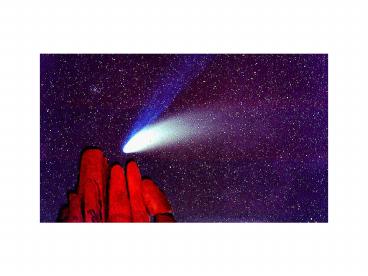Comets - PowerPoint PPT Presentation
1 / 30
Title:
Comets
Description:
Check list of currently visible or other newly discovered comets ... determine radius/size using occultation events - very precise timing, location dependent. ... – PowerPoint PPT presentation
Number of Views:80
Avg rating:3.0/5.0
Title: Comets
1
(No Transcript)
2
- Comets
- Easy to find, but only if you know what to look
for - - Dark location
- Patience
- Methodical
- Careful
If you think youve found a comet, you should
first Check a good atlas (galaxy, nebula,
etc.) Check list of currently visible or other
newly discovered comets (Websites) Check it
out again the next evening - note any motion
(position change)
3
- If it passes all these tests, then send it in to
the IAU Central Bureau for confirmation. - your name
- your address and contact details (e-mail address)
- date and UT time of observation
- observation method (e.g., naked eye, visual
telescopic observation, photographic, or
telescopic CCD) - specific details on instrumentation (aperture
size, f/-ratio, etc.) and exposures (type of film
or CCD, length of exposure, etc.) - observation site (name of location, giving either
city/town and state/province/country, or some
other geographical name nearby) longitude and
latitude and elevation above sea level can be
useful - If all goes well and they confirm it, youll
become Immortal!
4
Comet names Still use the old discoverer naming
system - but when too many are discovered by the
same person (or project), this is too
confusing First part of the name P/ - comet with
period lt 200 years C/ - comet with period gt 200
years D/ - comet that disappeared A/ - oops, an
asteroid
5
Year of discovery, followed by 1/2 month of
discovery code and order of discovery January
A, B JulyN,O February C, D AugustP,Q March
E, F SeptemberR,S April G, H OctoberT,U May
J,K NovemberV,W JuneL,M DecemberX,Y On
occasion some look asteroidal, and get a bit of
an asteroid name added in. C/2001 HT50
(LINEAR-NEAT) C/2001 Q4 (NEAT) C/2002 O7
(LINEAR) C/2002 T7 (LINEAR) 2P/Encke
29P/Schwassmann-Wachmann 1 43P/Wolf-Harrington
65P/Gunn 157P/Tritton
6
Brightness of a comet How do you measure it? One
method - defocus the telescope/binoculars How
bright should it be? Depends on - Distance from
Sun Distance from Earth Towards/away from the
Sun Size/age of the comet How close to the Sun
in the sky
7
Comet brightness estimate V H 2.5 n log (r)
5 log D Vintegrated magnitude H magnitude if 1
A.U. from the Sun, 1 A.U from Earth, also
considered the absolute magnitude n
typically 4 r Sun-comet distance (A.U.) D
Earth-comet distance (A.U)
8
Orbital elements for comets for orbit
prediction/tracking e eccentricity (0-1) i
inclination (degrees) T date of Perihelion q
perihelion distance (AU) W longitude of the
ascending node (degrees) w argument of the
perihelion (degrees)
9
Why study comets?
- Primordial
- Two populations
- Influence of solar winds
- Source of meteor showers
- See break-ups
- Unpredictable potential impacts
- Theyre just cool
10
Comet McNaught C/2006 P1
11
(No Transcript)
12
(No Transcript)
13
(No Transcript)
14
17/P Comet Holmes
15
(No Transcript)
16
(No Transcript)
17
(No Transcript)
18
Asteroids 160,000 observed 14,500 named
19
And how are asteroids named? Old names - Names of
gods, goddesses, people (real) New names - Year,
1/2 Month designation (same as comets) and order
of discovery (also a letter, no I) 2008NA,
2008NB, 2008NC,....2008NZ, 2008NA1,
2008NB1,....2008NZ1 2008NA2, 2008NB2,.............
...
20
Why study asteroids? Can determine radius/size
using occultation events - very precise timing,
location dependent. Brightness variations -
composition, rotation, size Asteroids found by
using before-after comparisons of a
region. Asteroids tend to be found in the
ecliptic.
21
(No Transcript)
22
(No Transcript)
23
(No Transcript)
24
But some vehicles are tougher
25
(No Transcript)
26
Meteorites - fragments of comets or
asteroids Most common Stony Macrometeorites -
big ones, look for burned features, crusts,
unusual location, color, metal detectors can
help Micrometeorites - small ones, rain down
continually
27
Iron - Nickel Meteorites
28
Martian Meteorites
29
Micrometeorites
30
- Collecting micrometeorites
- Magnets
- Collecting Dish/Surface
- Dishes/Containers
- Snow
- Use microscope to distinguish micrometeorites
from crap































